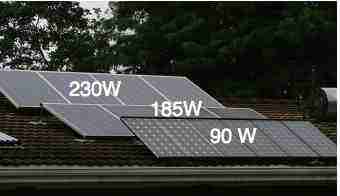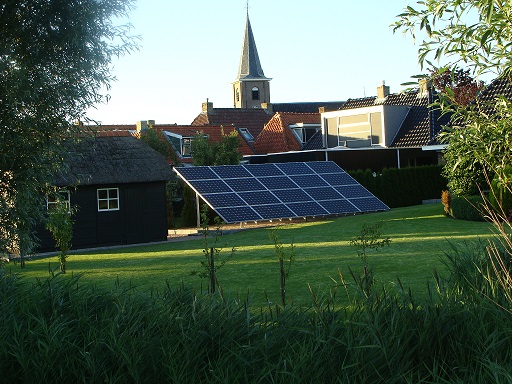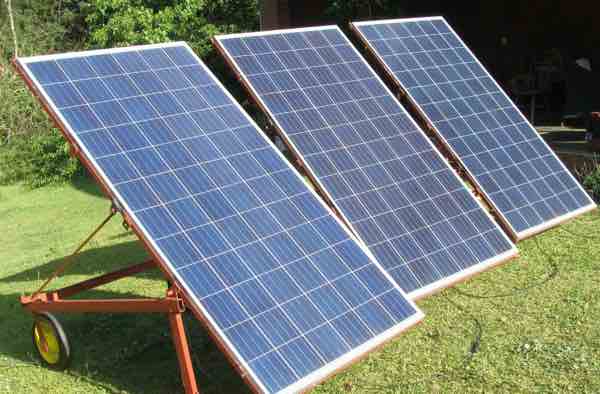- Bernard Preston homepage
- Solar geek
- Residential Solar Panels Pitch
Residential Solar Panels Pitch
Residential solar panels pitch considers whether there is an alternative to PVs on the roof of your home. It's unsightly, often creates leaks and installation is not simple.
This page was last updated by Bernard Preston on 5th January, 2021.
There are numerous difficulties associated with erecting PV-panels on your roof; here are a few that come to mind.
- You make holes in the iron with the attendant likelihood of some leaks.
- The performance drops significantly when the panels are on a hot-roof.
- Clambering around in the ceiling to do the wiring is both unpleasant and dangerous.
- The angle of the roof is almost certainly not the most beneficial.
- If there's ever a short-circuit and ensuing electrical fire, your home could burn down.

At what angle should you pitch your residential solar-panels, and on what sort of structure should you position them?
I could add others; like, in the case of our home, of necessity the panels are distant from the inverter. It makes sense to have your PVs close to the battery-room with short cables.
Then there's no doubt that they are a bit of an eye-sore, for your neighbours in particular. In fact, in some residential complexes, any structures on the roof are banned.
Having gone through the whole process of building a solar-generator on and in my home, facing all these difficulties, I would do it differently if I ever was to undertake a similar project again.
So if you're planning to go green and plug into Mr Golden-Sun as my granddaughter calls him, then perhaps give this at least some consideration; it is worth a thought.
Obviously it depends on the circumstances of your property; for some this wouldn't be feasible. But I suspect most of us could use some extra garaging for our cars, bicycles and lawnmowers; and your other hobbies. For example I wish I had a dedicated mead room[4] for brewing; it should be scrupulously clean.
Residential Solar Panels Pitch
Residential solar panels pitch invites questions about the angle of your PVs.
Instead of what I have above, I would build a separate garage or workshop, with a roof designed to have three areas; east, west and north-facing. On each I would put at least four or five square metres of panels. Below in immediate proximity would be the battery room.
In the photo below these residential solar panels are pitched just right, but of course they are shaded in the early morning. I spotted them in a small fishing-village in Holland; the Dutch are masters of harvesting water, wind and sunshine.
Shadows on PV panels is a very important consideration; block one and all those in series won't perform at all.

Ideally your panels should be at right-angles to the sun for maximum efficiency; that in itself creates difficulties. The angle of declination of the sun changes with the seasons.
There are highly sophisticated tracking-systems, but they are very expensive and most likely far beyond the average homeowner.
So mostly the recommendation is that your PVs should be angled to the declination of the sun. In my case that's 30-degrees but yours could be considerably more or less depending on how far you live from the equator.
In fact, because of the shorter-days in winter, and the sun is lower in the sky, you might want your residential solar panels pitched at an extra five or ten degrees.
But I settled for 30 degrees because our winters are dry and cloudless, whereas the summers are often wet and misty.
In our region, on average, our panels actually produce more energy in the winter, despite the shorter-days and lower declination, than in the summer.
Then to catch the early morning and afternoon sun, which is when most
of the power is often being used, I'd have two extra strings of panels
that are facing east and west.
They are dedicated to getting you extra energy for the morning coffee and breakfast, and preparing dinner; for that you would want maximum-power early and late in the day, when the sun is low. They need to be angled much more steeply, say at 45 or even 60 degrees, accepting they would be less efficient for the rest of the day.
So, to avoid using the roof of our house, what would I do? Firstly, the panels still have to be up high because our home is surrounded by lofty trees.
So, erecting them at ground level, which is certainly the best option, simply isn't feasible.
I would build a garage, with a pitched roof, but perhaps without cladding; the photovoltaic panels would be the covering to keep the rain and weather out. It may be necessary to put in a layer of sisilation to keep the building dry; or simply a silicone sealer.
At one end of the garage, I would build the battery room, and that would have to be properly walled and clad to prevent any rain getting in; water and electrical-equipment don't go together, do they?
Whether you decided to brick in the walls of the garage is up to you, and your circumstances. In South Africa we would certainly make the whole structure secure. But the battery-room itself must be safely enclosed.
That safe-room would also house the MPPT and inverter. They need to be as close to the batteries as possible as the voltage is low, and the current very high; that means big heat losses in the cabling.
Using a scaffolding it would be very easy to work under the panels, connecting up the wiring. Clambering around in the ceiling was pure misery.
The inverter produces high-tension 110 or 220V, AC, so the current is relatively low, according to the formula, power is equal to the product of the amps and volts.
Raise the battery voltage from 48V, which is the recommended option, to that of the mains and the current halves or quarters depending on where you live. Since heat loss is proportional to the amps squared, so sending your electrical power some distance to your distribution board is much less of a consideration.
The high-tension line would either be strung across the gap between the battery room and the mains distribution board in your home, or buried underground.
So, there's no clambering around in sweltering ceilings and no danger of electrical fires damaging your home; and you have gained a garage at nominal cost for your car or paraphernalia. The photovoltaic panels could be the cladding if you can get Elon Musk's tiles.
If you're fortunate enough to work from home, it's the perfect place to charge your electric-car or motorcycle during the day when the power is free.
And the cabling between the panels and the MPPT is shorter than usual; less cost of copper-wiring, and fewer losses. I should get 3200W from my panels but because of the long cabling, it's less.
Now with the extra 930W of west facing solar panels we regularly maximise at 3500W and more.
Residential solar panels pitch; make it the angle of the declination of the sun at your latitude, and build a dedicated structure to support the panels and house the batteries, inverter and MPPT.
Read more about Joule heating at Wikipedia, if you are interested.
Worth a thought, eh?
Tip from Uncle Bernie
Bite the bullet and purchase at least a 60A MPPT, 5KVA inverter and a minimum of 3kW of panels, allowing for more if need be in time.
I did not plan properly and went from a 2kw inverter, to 5 and then 10. You should be smarter and go big the first time to avoid the necessity of a solar powered generator upgrade.
And if you have a large expanse of ground, and no trees shading the area, put your panels on the ground; otherwise build your residential solar panels, as suggested, pitched on a separate building.
Grid tied
Grid tied is my first choice if you have a good utility, but in many third-world countries the power goes off every day, and brownouts are common; you need expensive batteries. But either way, the residential solar panels pitch is important.
Grid tied residential solar power is the alternative.
Avoid another mistake I made; whilst your PV panels facing due south in America, should be at the angle of declination, should you decide to include west and east facing solar panels for the late afternoon sun, make them steeper for when the sun is low in the sky. Most homes have too much energy in the middle of the day and not enough for preparing breakfast and dinner.
Just what are the options in terms of grid tied, batteries and the mains supply? Read more at total blackout. Just what happens if your utility company loses control of the grid?
Solar PV systems further considers the pros and cons of being grid tied; if you have batteries always make provision for a knifeblade fuse.
MPPT
The MPPT, or maximum power point tracker, is a smart, ingenious device that, by keeping the voltage in the cabling high, enables you to extract about a third more energy from your panels. It's dependent on the voltage of each string being equal, or at least nearly the same, so residential solar panels pitch is important.
So, your string of east-facing panels would need a separate MPPT, as would those looking out to the west.
In short, one large MPPT, probably 60 amps, for the panels that are north or south facing, and two smaller for the east and west PVs; the voltages would be too disparate to have only one.
For more information, you can read up about the solar charge controller MPPT here; you have to have at least one if you have batteries.
Mobile solar carts
I'm having fun with mobile solar carts. They have two distinct advantages; you can easily change the residential solar panels pitch, and secondly move them to follow the sun. You get 1.6 times the output; or three panels is equivalent to five.
Right now I'm doing a lot of work on them to make them more user-friendly; these are Mark II and and plenty of upgrading is happening.
I hope to have a plan ready in the future so you can build them at home yourself; these are working great but the design is being improved. Be patient and wait a bit if you want to make one.
The biggest advantage is early morning and late-afternoon power that north or south facing panels will not provide.

Model III will be all three panels on one cart so they can be turned together; currently it is a bit of PT.
The biggest advantage having an excess is that micromanaging your solar generator is far less of a problem. In full sunshine you know can turn on the electric oven or dishwasher without having to go and check out first how much power the sun is generating for you.
Useful links
Bernard Preston
Bernard Preston's blogs are about the joys of being a greenie, but it is not entirely altruistic. If each person enjoying this page would buy just one of my books it would pay for the site-management. If you bought two it would contribute to my residential solar panels pitch, and all the other paraphernalia!
My books have been called healthful and funny; they look at the quirky side of life inside of a DC's clinic. Try one of the free chapters before buying. Stones is only available as an ebook to be read on your smartphone, tablet or Kindle. Now $3 will not break the bank, eh, if you are loving this site. That is the joy of ebooks; if you do not like them, nothing lost.
But there is much to be gained from Stones in my Clog; a free tour of the polders of Holland if nothing else.
Newsletter
Our newsletter is entitled "create a cyan zone" at your home, preserving both yourself and Mother Earth for future generations; and your family too, of course. We promise not to spam you with daily emails promoting various products. You may get an occasional nudge to buy one of my books.
Here are the back issues.
- Investing in long-term health
- Diseases from plastic exposure
- Intensive lifestyle management for obesity has limited value
- A world largely devoid of Parkinson's Disease
- The impact of friendly bacteria in the tum on the prevention of cancer
- There's a hole in the bucket
- Everyone is talking about weight loss drugs
- Pull the sweet tooth
- If you suffer from heartburn plant a susu
- Refined maize meal and stunting
- Should agriculture and industry get priority for water and electricity?
- Nature is calling
- Mill your own flour
- Bake your own sourdough bread
- Microplastics from our water
- Alternative types of water storage
- Wear your clothes out
- Comfort foods
- Create a bee-friendly environment
- Go to bed slightly hungry
- Keep bees
- Blue zone folk are religious
- Reduce plastic waste
- Family is important
- What can go in compost?
- Grow broad beans for longevity
- Harvest and store sunshine
- Blue zone exercise
- Harvest and store your rainwater
- Create a cyan zone at your home
Did you find this page interesting? How about forwarding it to a friend, or book and food junkie? Better still, a social mead tick would help.
- Bernard Preston homepage
- Solar geek
- Residential Solar Panels Pitch
Address:
56 Groenekloof Rd,
Hilton, KZN
South Africa
Website:
https://www.bernard-preston.com